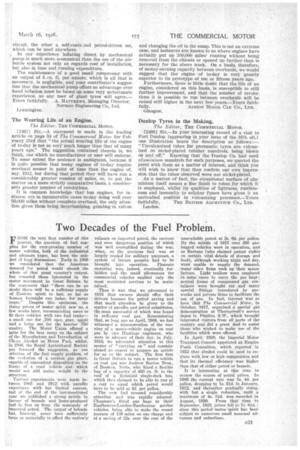Two Decades of the Fuel Problem.
Page 57

If you've noticed an error in this article please click here to report it so we can fix it.
FROM the very first number of this V journal, the question of fuel supplies for the ever-growing number of motor vehicles, both of the industrial and pleasure types, has been the subject of long discussions.. Early in 1905 we considered that the American demand for petrol Would absorb the whole of that great country's output. but consoled those interested in the motor movement in Great Britain by the statement that "there can be no doubt there -.will be a sufficient supply of Eastern spirit to last, so far as human foresight can judge, for many years." Despite this optimism, the rising prices of motor spirit saw us, a few weeks later, recommending users to fit their vehicles with two fuel tanks— a small one for .700 spec. gray, spirit and a large one for the heavier .750 quality.. The Motor 'Union offered a prize for the best essay on the subject of the Manufacture and Introduction of Cheap Alcohol as Motor Fuel, whilst, In 1906, the Royal Agricultural Society put forward the suggestion, as one sblution of the fuel supply problem, of the evolution of a suction .gas plant, capable of convenient disposition on the frame of a road vehicle and which wonld not add undue weight to the structure.
Various experiments were made between 1905 and 1912 with paraffin vaporizers, with but limited success. and at the end of the last-mentiOned year we published a strong article in favour of benzoic and home-produced fuel to free us from the monopoly of imported petrol. The output of benzoic has, however, never been sufficiently large as materially to-affect the nation's
reliance on imported petrol, the onerous and even dangerous position of which was well exemplified during the war, when, as the precious fuel was so largely needed for military purposes, a system of licence permits had to be brought into operation. Pleasure motoring was, indeed, eventually forbidden and the small allowances for commercial vehicles enabled only the most restricted services to be maintained.
Thus it was that we advocated in 1916 that owners should offer their drivers bonuses for petrol saving and that much attention be given to the matter of paraffin and petrol substitutes, the most successful of which was found in ordinary coal gas. Remembering that, so long ago as April, 1909, we had witnessed a demonstration of the running of a motor-vehicle engine on coal gas by two Hastings engineers, who were in advance of their day, in July, 1916, we advocated attention to this means of "carrying on" and commissioned an expert to prepare an article for us on the subject. The first firm in Great Britain to run a motor vehicle on coal gas was Andrew Barton Bros., of Beeston, Notts, who fitted a flexible bag of a capacity of 450 cu ft. to the roof of a Ryknield single-deck bus, which they claimed to be able to run at a, cost to equal which petrol would have to he sold at 4d. per gallon.
The new fuel aroused considerable attention and was rapidly adopted. Chapman's fitted gas begs to their Eastbourne-Len don-Eastbourne service vehicles, being able to make the round journey of 130 miles on one charge and at a saving of 22s. over the cost of the unavailable petrol at 2s. 6d. per gallon. By the middle of 1917 over 350 gasbagged vehicles were in operation, and as Bartons (who claimed patent rights on certain vital details of storage and feed), although working night and day, were unable to supply the demand, many other firms took up their manufacture. Light trailers were employed in some cases to carry the gas begs; several forms of compressed gas containers were brought out and many special fittings introduced by gasworks and private firms to facilitate the use of gas. In fact, interest was so keen that The Commercial Motor. in October, 1917, organized a special gas demonstration at ThornyCroft's service depot in Pimlico, S.W., which brought interested visitors from all parts of the country and did a great deal to assist those who wished to make use of the facilities which were offered.
In April, 1920, the Imperial Motor Transport Council appointed an Empire Fuels Committee, which reported in 1922 that alcohol could be used in en-• glues with low or high compression and that its thermal efficiency. was higher than that of either petrol or benzoic.
It is interesting at this time to review the course of petrol prices. In 1906 the current rate was is. 4d. per gallon, dropping to 1s. 21d. in January, 1912, and thereafter gradually rising, with but a single reduction, until a maximum of 4s. 34d. was recorded in August, 1920. From that time to September, 1923. prices fell to 1.s.
since this period motor spirit has been subject to numerous small seasonal advances and redactions.


























































